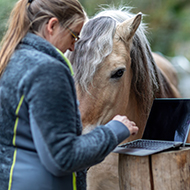Study identifies new breed associations for Cushing's syndrome in dogs

Dogs with Cushing's syndrome were identified by searching electronic patient records of primary-care veterinary practices.
An epidemiological study has identified several novel breed associations for Cushing's syndrome in dogs.
The largest epidemiological study to estimate the prevalence and risk factors for Cushing's syndrome to date, the study discovered that the Border terrier, the Lhasa apso and the Staffordshire bull terrier have increased odds of Cushing's syndrome compared with crossbreed dogs in the UK primary practice population.
Published in the Journal of Small Animal Practice (JSAP), the study identified dogs with Cushing's syndrome from electronic patient records of practices participating in the UK VetCompass programme during 2016.
Explaining the findings, Dr Imogen Schofield, corresponding author for the paper, said: A total of 1527 Cushing’s syndrome cases were identified in this study, from a population of 905,544 dogs in 2016. The estimated one-year period prevalence for Cushing’s syndrome in dogs was 0.17 per cent.”
Dr Schofield identified seven breeds which had increased odds of Cushing's syndrome, the bichon frise, Border terrier, miniature schnauzer, Lhasa apso, Yorkshire terrier, Staffordshire bull terrier and Jack Russell terrier.
“Dogs with a bodyweight higher than their breed-sex mean had 1.44 times the odds of Cushing’s syndrome than those within their breed mean suggesting either over-weight dogs or larger examples of the breed are at increased risk of this condition, or that dogs with Cushing’s syndrome gain weight,” added Dr Schofield.
Nicola Di Girolamo, editor of JSAP, discussed the study: “When we look at risk factor analysis in previous studies, the generalisability of their findings to the general population of dogs in the UK have typically been limited due to studying dogs from referral populations or due to a lack of multivariable analysis.
“The findings of this study help to address that knowledge gap, supporting some of the risk factors previously reported, and by identifying novel associations, such as that in the border terrier.
“Awareness of breeds with high or low risk could help to enhance the index of suspicion for veterinary surgeons working in primary-care practice where Cushing’s syndrome is predominantly diagnosed and managed.”
'Frequency and risk factors for naturally occurring Cushing's syndrome in dogs attending UK primary-care practices' can be read here.



 With Strangles Awareness Week just around the corner (5-11 May), vets are being encouraged to share a survey about the disease with their horse-owning clients.
With Strangles Awareness Week just around the corner (5-11 May), vets are being encouraged to share a survey about the disease with their horse-owning clients.